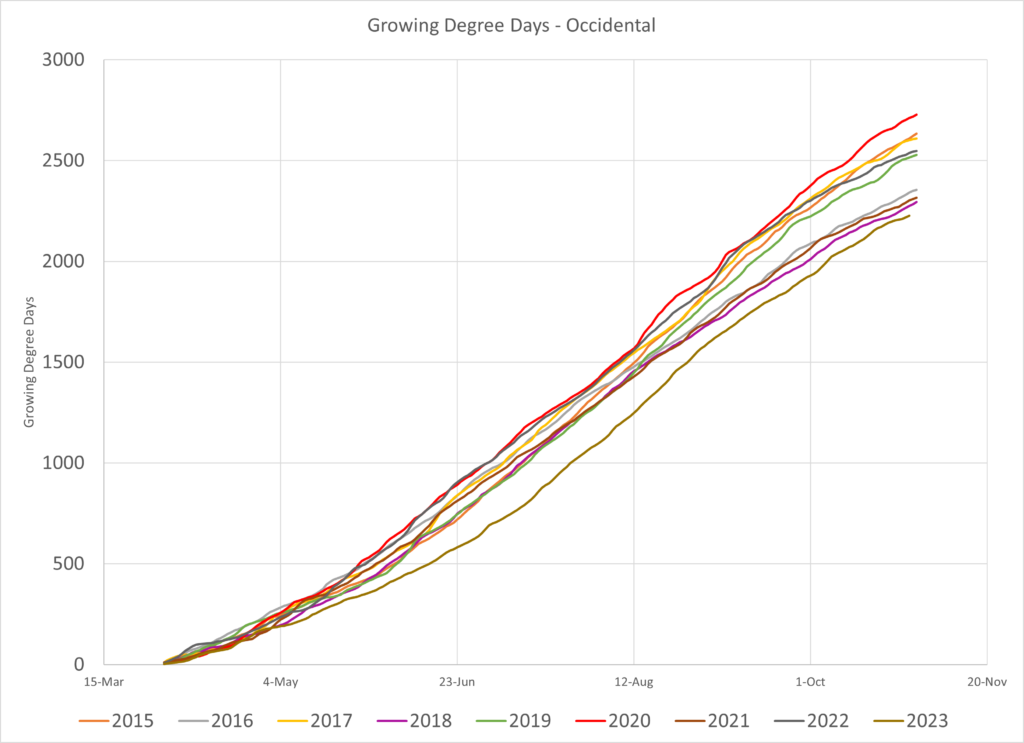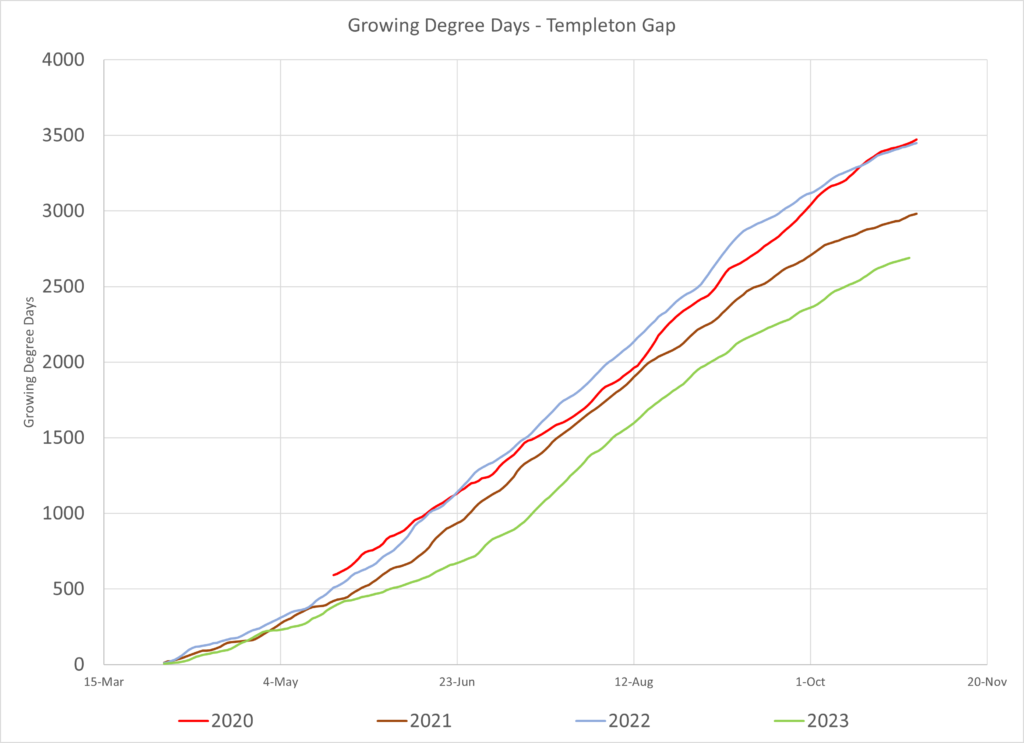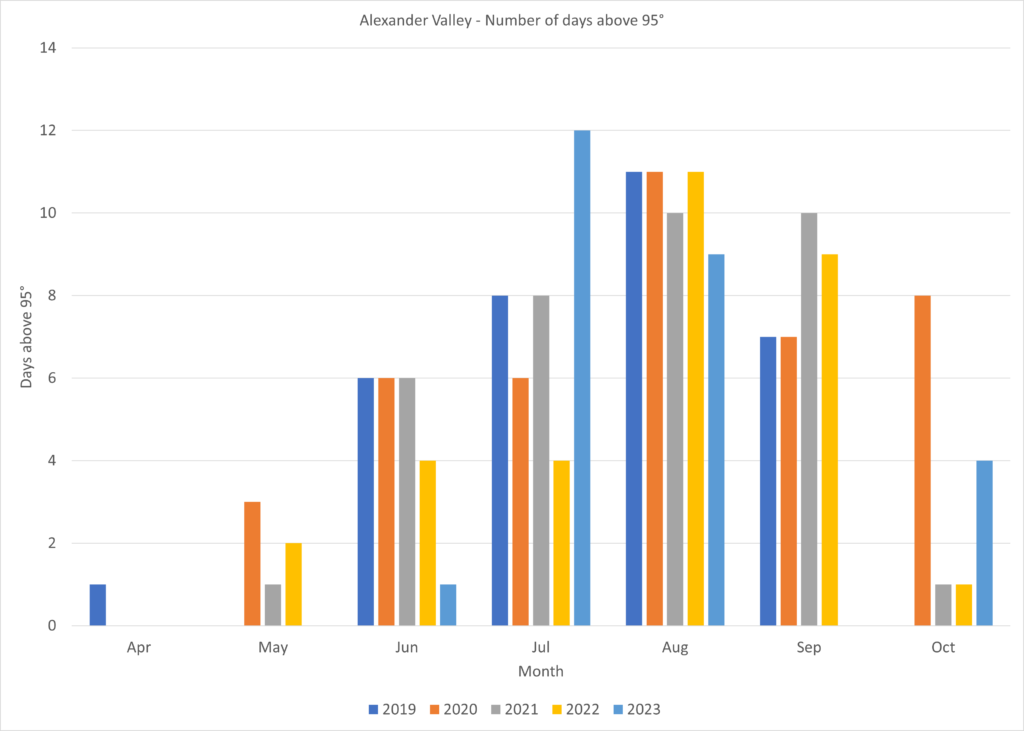Yesterday marked the official end of the growing season and what a season it was, amiright?? 2023 has proven to be polarizing. For some growers and winemakers, this was a remarkable year for quality, and others are just thankful to have crop insurance. Let’s take a look at why this is.
I wrote about how 2023 was shaping up back in July when I looked at how Growing Degree Days (GDD) were stacking up compared to other years. GDDs are typically calculated by taking the average of the daily minimum and maximum temperature and subtracting a base number, in this case 10°C (50°F). Back in July, most places sampled were around 300 GDDs behind previous years. After rerunning the temperature data this week, it looks like the season never caught up.
Here’s a spot in Alexander Valley, Sonoma.

Here’s one in western Sonoma County.

Let’s take a look at Templeton in San Luis Obispo County

And another one in Eastern Paso Robles, which shows the starkest difference. 2023 is 339 GDDs behind 2022 and 788 GDDs behind 2021!

Early season woes
Back in July we had just come out of an exceptionally wet and persistently chilly winter and early spring, which had delayed budbreak to what we used to thing of as a “normal” time for buds to start pushing. This meant the ugly frost season that characterized 2022 and 2021 spared us this year. However ongoing cold temperatures throughout the spring kept holding the season back and made for a long and drawn-out bloom period. As of July, it was already apparent that many vineyards had been hit with shatter…hard.
It’s worth mentioning that the shatter situation this year was certainly a learning experience when it comes to meso and even microclimate. Bloom was so stretched out this year that your set really depended on what stage your particular vineyard was in when the temperature dropped. In some places, there was great set and crappy set in the same block.
The vines’ phenological cycle is mostly driven by spring temperatures. When that is late, the whole season is shifted and making up for lost time is just not going to happen. Where we saw poor set (and in many cases even where we saw good set), we also saw uneven berry development. When berries set at different times, even within a cluster, the clock starts ticking for them at different times and persists throughout their development. Veraison was very late this year and when it finally arrived it also took forever to wrap up. Seems like there were hard, green berries remaining on clusters for weeks even after veraison had begun.
Why is this a great year?
For some growers 2023 is looking to be a great year. Some winemakers were raving about excellent quality despite the fact that some vineyards pulled off record yields. The record yield part probably has to do with the water we got this winter. Vines went into the spring with a nice full soil profile. This had a huge effect in the Central Coast, where for the last few years growers have relied solely on early season irrigation to promote canopy development. Not only did vines have plenty to drink, they also had access to more nutrients than usual since they could tap into the entire soil mass as opposed to just the small volume of moist soil under the drip emitters. If the weather spared you, you probably had pretty good set because you had a nice big canopy to support flowering. Then all you had to do was ripen it…foreshadowing…
To better understand reports of great quality this year, I attempted to drill down on the temperature data. There were accounts of brix just “cruising” as some growers put it, which meant that brix was accumulating over time at a normal rate. Was this due to perfect temperatures? Growing Degree Days are calculated using 50°F (10°C) as the base temperature however the optimum temperature for grapevine photosynthesis is from 77° to 95°F (25°-35°C). I wanted to see if, once we were past the cold spring, this season was actually better than other years when it comes to conditions for ripening, or at least the sugar accumulation part of ripening.
The answer is no.
If you look at just the ripening period starting at veraison (let’s call it mid-August this year), 2023 was still behind most of the previous seasons. Even in places where it was close, the fact that this season got such a late start and thereby started accumulating sugar later on than other years meant that the ripening season was both cooler and shorter.
The below graph shows how the period of sugar accumulation compares to previous years in the Alexander Valley. This year is still behind.

Weather extremes were markedly absent this year. If anything, this is why 2023 is looking like a great year for so many. Grapevine photosynthesis is dramatically curtailed at temperatures above 95°. Anything higher than 105° can cause irreparable damage to the grapes’ ability to mature fruit. This is what happened in the summer of 2022 and the spring of 2021 with the expectedly unfavorable results. If sugars seemed to “cruise”, as some claim, it’s just because nothing went horribly wrong, as opposed to everything going fantastically well.
The below graph shows number of days above 95° experienced in the past 5 years.

…and the number of days above 100°…

…and days over 105°.

As far as ripening goes, the other take away is that California is a pretty advantageous place to grow grapes. According to the UC Davis Heat Summation Scale, region II varieties such as Merlot and Cabernet Sauvignon need a minimum of 2500 GDD (up to 3000 GDD) to adequately ripen, with Merlot being somewhere in the middle of that range and Cab being closer to the upper end of that range. There are many regions that manage to ripen Chardonnay and Pinot with as few as 1800 GDD. These are general thresholds, but for the most part California is an overachiever when it comes to sun and warmth. All places sampled were well above these lower limits.
Why was this a bad year?
Well for one, mildew was crazy, which happens when we have moderate temperatures and don’t see high ones. This was not a year to be shy about leafing your Chardonnay that’s for sure. It was also a tough year to be organic. One nice thing about heat events is that they stop mycelial growth of powdery mildew. It’s a double-edged sword in this respect.
If you had a really hard time ripening your fruit, you probably overcropped the vines. When growers get hit with shatter, sometimes the prevailing thought is that the weather thinned for you. That’s not really the case. Clusters may have been looser but berries caught up weight-wise by the time that harvest rolled around. Moreover, the shatter and drawn-out fruit set caused ripening to be out-of-phase so if you didn’t thin your crop that meant plenty of pink berries in the mix pulling down your brix levels. Also, not all shoots can ripen a cluster. If the shoot is less than a foot tall, slice the fruit off. Even in the peachiest of years, you aren’t going to ripen anything with a grape-area bigger than the leaf-area.
Farming is a lot like gambling, and many growers lost their bets this year. If you banked on things warming up, that didn’t happen. The fact that the whole season is three plus weeks behind truncated the growing season leaving some people out of luck and out of time. Growers need to manage to the season. If it’s delayed at fruit set, it’s going to be delayed at harvest – if you get there at all.
Another mistake came from cutting off the water when you shouldn’t have. The only thing that can increase sugar in grapes is an active canopy. An elongated season means that you need your canopy to hang in there for the long haul. Otherwise, you can rely on dehydration to push up your brix, but that comes with a whole lot of other problems. If the canopy is senescing, all those yellow leaves export their nutrients directly into the berries. This includes potassium. I hear every so often winemakers scratching their heads over a fermentation with high pH and high TA…I think this may have to do with grapes from a senescing vineyard. The chemistry just goes wonky.
This was not a year to panic. Many growers cut water in early September when there was still time to ripen your fruit naturally as opposed to letting it dehydrate until it reaches desired brix levels. There’s an argument that cutting the water causes the vine to go into some kind of “ripening mode”. Abscisic acid (ABA), which is triggered by stress, is important when it comes to initiating the ripening process (by stimulation of secondary metabolic enzymes), but not when you need to finish it. Sugar is a primary metabolite and is a product of good old photosynthesis. Photosynthesis needs water and if your canopy is senescing due to late-season water stress, there is simply no sugar to export to your grapes. You can only raise brix that way by berry dehydration, which is frowned upon by both growers and winemakers alike.

Others panicked by harvesting super early to avoid small amounts of rainfall. Back when I was in Italy, we would get torrential rainfall every fall that would often divide Nebbiolo producers into those that harvested prior and those that harvested afterwards. Sometimes it paid off to wait and other times it didn’t. Did it get botrytis? Absolutely. Outside of California the tolerance for imperfect fruit is far more lenient. I tend to prefer adequately ripened fruit to fruit that is underripe. Unfortunately, I don’t see attitudes towards botryris changing anytime soon, especially with grape-glutted wineries looking for any reason at all to reject fruit.
Conclusion
This was a cool year, both figuratively and literally. I can’t wait to taste it!

